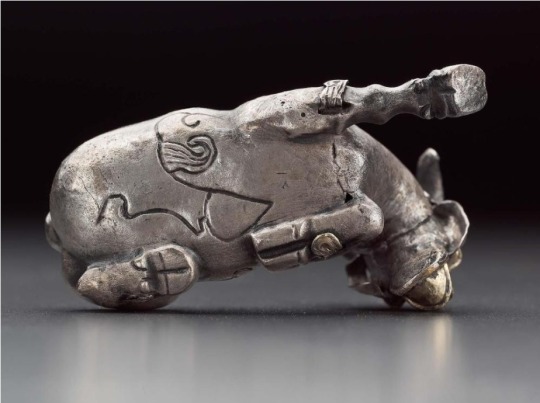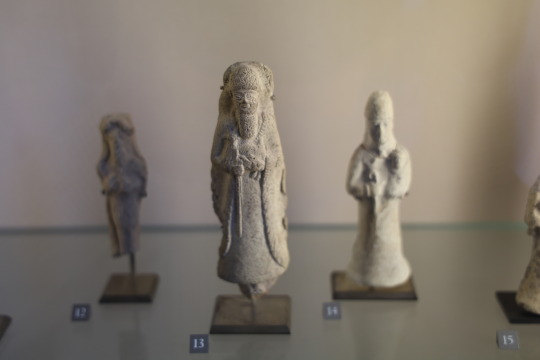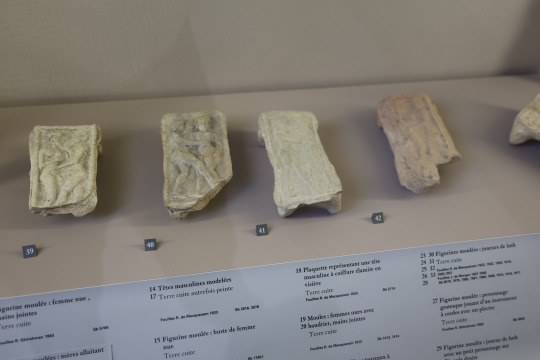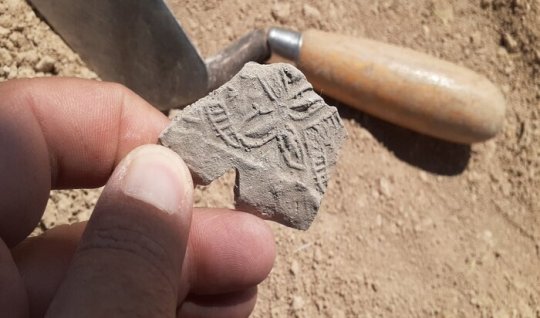#elamite
Explore tagged Tumblr posts
Text

kneeling bull holding a spouted vessel | ca. 3100–2900 BCE | proto-elamite
in the met museum collection
2K notes
·
View notes
Text

An Elamite Copper Zebu,
Circa Late 3RD Millennium B.C.
Standing, the head with projecting ears and short, tapering, curving horns, almond-shaped eyes with concentric rings, prominent neck hump and dewlap, and long, straight tail reaching down to its hooves.
5¾ in. (14.6 cm.) long
458 notes
·
View notes
Text

Bronze axe head, Elamite, early 2nd millennium BC
from The Princeton University Art Museum
248 notes
·
View notes
Text

This limestone hedgehog, mounted on four wheels, was discovered near the temple of Inshushinak in Susa, Iran, dating to the Middle Elamite period, circa 1500-1200 BC. The piece is currently on display at the Louvre Museum.
156 notes
·
View notes
Text


~ Mountain goat.
Place of origin: Near Eastern, Iranian
Period: Elamite, Proto-Elamite
Date: 3500–2700 B.C.
Medium: Silver and sheet gold.
#ancient#history#ancient art#museum#archeology#ancient sculpture#ancient history#archaeology#iran#iranian#near east#near eastern#elamite#3500 b.c.#2700 b.c#silver#goat#mountain goat
2K notes
·
View notes
Text
Hedgehog on Wheels, from Iran, c.1500-1100 BCE: this 3,500-year-old figurine of a hedgehog on a wheeled platform was found with several similar artifacts depicting animals on carts

The body of the hedgehog measures just 2.8cm long (about 1.1 inch) and was crafted out of limestone, while the cart was made using a bitumen compound. The hedgehog's feet are attached to four round sockets located at the front of the cart.

There are eight more empty sockets at the back of the platform, and their pattern/spacing could indicate that two smaller hedgehogs were originally mounted on the cart just behind this larger one, like a pair of baby hedgehogs following their mother.

The hedgehog was found with another figurine depicting a lion on a wheeled platform. Both of these artifacts were unearthed at the Temple of Inshushinak, located in what was once the ancient city of Susa; they date back to the Middle Elamite Period, c.1500-1100 BCE.

Their original function/significance is still widely debated, with some experts arguing that they were created as toys, while others argue that they were used as votive offerings. Their presence in the temple suggests that they likely had some cultural/ritual significance, but it's important to note that those two explanations may not be mutually exclusive -- some artifacts were used as both toys and ritual objects.
The distinction between those two terms is not necessarily as clear-cut as it seems, because toys are often incoporated into ritual contexts (as offerings or grave goods, for example) and they can also be used to familiarize children with rituals and religious beliefs.

Regardless of why they were made, they are strikingly adorable.
Sources & More Info:
The Louvre: Hedgehog Toy & Lion Toy
Metropolitan Museum of Art: Artifacts from The Royal City of Susa
Journal of the British Institute of Persian Studies: Probing the Margins in Search of Elamite Children
Portrait of a Plaything: Hedgehog
Cambridge University Press: Ritual, Play, and Belief in Evolution and Early Human Societies
#archaeology#artifact#history#anthropology#hedgehog on wheels#toys#votive offerings#susa#elamite#iran#ancient art#hedgehog#ancient toys#ritual artifacts#children in archaeology#art#sculpture#animal figurine#ancient near east
141 notes
·
View notes
Text

Many folc sprecan þæt ealdne tunge.
I noticed this too the last time I was at my dermatologist. I was tempted to pick Elamite just to show off. "Yes, I'm here about the arrow I took to the knee and also this offer of fine quality copper from the best number one seller my dear friend Ea-Nasir."
40 notes
·
View notes
Photo





Terracottas from Susa, Iran Middle Elamite period, 14th-12th centuries BCE
Musée du Louvre
190 notes
·
View notes
Text

"This mold-made female figure is depicted with a patterned headdress and wears crossed shoulder bands that hang thought a slip ring between her breasts and are incised with a herringbone pattern. She is adorned with a necklace, three bracelets on each wrist, and anklets. She holds her breasts in her hands, her enlarged pubic triangle is made up of rows of curls, and her flat but fleshy body and distended legs are characteristic of nude female figures of this period. The figure confronts the gaze of the viewer with her wide, rimmed eyes."
28 notes
·
View notes
Text

Cyrus the Great "King of Kings of the Achaemenid Empire"
Following the Persian conquest of Babylon, Cyrus issued the Edict of Restoration, in which he authorized and encouraged the return of the Jewish people to what had been the Kingdom of Judah, officially ending the Babylonian captivity. He is mentioned in the Hebrew Bible and left a lasting legacy on Judaism due to his role in facilitating the return to Zion, a migratory event in which the Jews returned to the Land of Israel following Cyrus's establishment of Yehud Medinata and subsequently rebuilt the Temple in Jerusalem, which had been destroyed by the Babylonian siege of Jerusalem. According to Isaiah 45:1,[14] Cyrus was anointed by Yahweh for this task as a biblical messiah; he is the only non-Jewish figure to be revered in this capacity.
Painting from Charles Texier for Cyrus The Great, Paris, 1852
#jewish history#judea#israel#kingdom of judah#persian#achaemenid empire#king#history#persians#elamite#nopalestine
2 notes
·
View notes
Text

vessel in the form of a boar | ca. 3100-2900 BCE | proto-elamite
in the met museum collection
150 notes
·
View notes
Note
I'm low-key losing it, do you have any idea what the abbreviation RIMI, by Christopher B.F. Walker 1981, might refer to? CDLI lists it as having the publications of a bunch of Middle Elamite stuff (such as this lovely iron ring) but all I can find is Walker 1981, Cuneiform Brick Inscriptions in the British Museum. I figured it might be some long-lost Iranian RIME spin-off but no hits for that. I've checked the AfO register and there's nothing. Any clue?
Hello! Sometimes an ask leads me on a deeper hunt than I ever expected.
I also couldn't find a reference for RIMI - but based on the pattern of other Royal Inscription of Mesopotamia projects (a series of publications from the University of Toronto), my best guess is that the I does stand for Iranian. Here's an Oracc article on the history and significance of royal inscriptions, with citations to several of the publications.
I ended up reaching out to the Museum of Fine Arts Boston, where the ring you linked is housed. After a couple calls referring me to different departments, I learned that RIMI is almost certainly a translation project in the RIM series that C.B.F. Walker never finished or published. I'm not sure why it's listed as 1981, since the MFA's records have "no date (of publication)". 1981 is also before the MFA acquired the ring in 1985, and they have no known translation work done on it since then - so it's possible the only person who's every translated the text on the ring is Walker himself.
They did refer me to one other reference about this ring, though, also from 1981 - Muscarella's article on Surkh Dum excavations in the Journal of Field Archaeology (JStor link, the ring section is p. 344). I can't tell exactly what ring in that article is referring to this particular one, but one is mentioned as having the inscription dingir-mesh (Sumerian for "they are gods" or "... are the gods"), which Muscarella says is "part of a prayer invoking the gods." On the rings, Muscarella cites Porada 1964 ("Nomads and Luristan Bronzes", which I can't find a link for, but you can find a description of her work in this 1989 Encyclopaedia Iranica article).
Circling back to Walker, he was a curator of Western Asiatic antiquities at the British Museum, so I reached out to them next. I learned that they don't keep contact info for retired staff members, and I don't know of another way to contact him (or even where he is now). Unfortunately this is a frequent issue I've encountered in Mesopotamian research - somebody works on things, doesn't end up publishing, and then retires or changes field, taking everything with them.
If there's an Elamite expert who might have any other leads, please let me know! (And special thanks to Paul at the MFA Boston library for your help in this search!)
13 notes
·
View notes
Text

Green tuff cylinder seal, Proto-Elamite, circa 2800 BC
from The British Museum
231 notes
·
View notes
Text

an elamite horror is born
#my art#artists on tumblr#digital art#character design#original art#original character#folklore#elamite#elam#iranian#oc#mythology#horror#historical#sketch
18 notes
·
View notes
Text
Thrilling archaelogical dicoveries

TEHRAN—Archaeologists in western Iran have found over 1,000 clay seals (and fragments) along with other “important” relics estimated to date from the Elamite era (3200–539 BC).
“We unearthed arrays of important objects such as over 1,000 clay seals while conducting an urgent excavation on an archaeological hill in Kermanshah province,” IRNA quoted archaeologist Shokouh Khosravi as saying on Monday.
Moreover, a number of earthen animal figurines and counting objects belonging to the early Elamite culture have been discovered in these excavations, Khosravi, who leads the excavations said.
“Those objects are unique in their kind in western Iran,” she said.
The archaeologist said those findings mark the first archaeological materials of the Elamite period in the west of the central Zagros region
“The finding triggers fundamental changes in our understanding and knowledge about the situation of western Iran in the fourth millennium BC,” Khosravi stated.
During the excavation, which is authorized by the Research Institute of Cultural Heritage and Tourism, a large number of clay door locks, hundreds of pieces of container seals, and a cylinder seal were also found, which shows the site was an administrative center for organizing economic and exchange affairs in the early Elamite period, she explained.
“As the excavations continue, more information will be obtained about the nature and absolute history of settlement on the site.”

Experts say the Kermanshah region has had one million years of archaeological continuity, which is due to the geographical features such as a high number of springs and fertile soil.
Elam, or the Elamite kingdom, was one of the most impressive civilizations of the ancient world. Its territory was once in a region, which is now situated in the modern Iranian provinces of Ilam and Khuzestan.
However, according to sources, it was never a cohesive ethnic kingdom or polity but rather a federation of different tribes governed at various times by cities such as Susa, Anshan, and Shimashki until it was united during the Middle Elamite Period, briefly, as an empire.
The name Elam was given to the region by others– the Akkadians and Sumerians of Mesopotamia–– and is thought to be their version of what the Elamites called themselves– Haltami (or Haltamti)– meaning “those of the high country.” 'Elam', therefore, is usually translated to mean“highlands” or “high country” as it comprised settlements on the Iranian Plateau that stretched from the southern plains to the elevations of the Zagros Mountains.
Susa was formerly the capital of the Elamite Empire and later an administrative capital of the king of Achaemenian Darius I and his successors of 522 BC. Throughout the late prehistoric periods, Elam was closely tied culturally to Mesopotamia. Later, perhaps because of domination by the Akkadian dynasty (c. 2334–c. 2154 BC), Elamites adopted the Sumero-Akkadian cuneiform script.
Documents from the second period, which lasted from the 16th to the 8th century BC, are written in cuneiform; the stage of the language found in these documents is sometimes called Old Elamite. The last period of Elamite texts is that of the reign of the Achaemenian kings of Persia (6th to 4th century BC), who used Elamite, along with Akkadian and Old Persian, in their inscriptions. The language of this period, also written in the cuneiform script, is often called New Elamite.
Although all three stages of Elamite have not been completely deciphered, several grammatical features of the language are known to scholars. These include a plural formation using the suffix -p, the personal pronouns, and the endings of several verb forms.
Elamite language is an extinct language spoken by the Elamites in the ancient country of Elam, which included the region from the Mesopotamian plain to the Iranian Plateau. According to Britannica, Elamite documents from three historical periods have been found. The earliest Elamite writings are in a figurative or pictographic script and date from the middle of the 3rd millennium BC.
Just to notice how the name Elam was written, n the various languages of the ancient times: Liner Elamite:hatamti Cuneiform Elamite: 𒁹𒄬𒆷𒁶𒋾 ḫalatamti; Sumerian:𒉏𒈠 elam; Akkadian:𒉏𒈠𒆠 elamtu,hebrew:עֵילָם ʿēlām, Old persian:𐎢𐎺𐎩 hūja
Source: https://www.tehrantimes.com/news/489442/Amazing-archaeological-finds-dating-back-to-Elamite-era-unearthed
#Iran#ancient Persia#archaelogy#Kermanshah#Khuzestan province#Susa Iran#Elamite#Zagros mountain#archaeologist#TehranTimes#Travel Iran#ancient city#ایران#Tehrantimes
3 notes
·
View notes
Text
Elamite woman from Susa, Iran - 8th century BC

Elamite woman, from the ancient civilization of Elam (Iran).
She is spinning the thread with the spindle.
She is sitting on a chair, one leg is placed under the other.
Behind the Elamite lady, her servant is fanning her.
A table with a plate of food (fried fish) is placed in front of her.
Follow my YouTube channel. Silent tablets documentary, short videos from ancient history.
Follow my Twitter.
3 notes
·
View notes